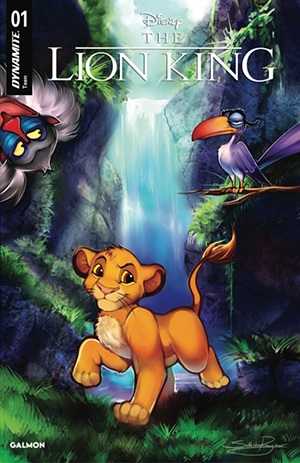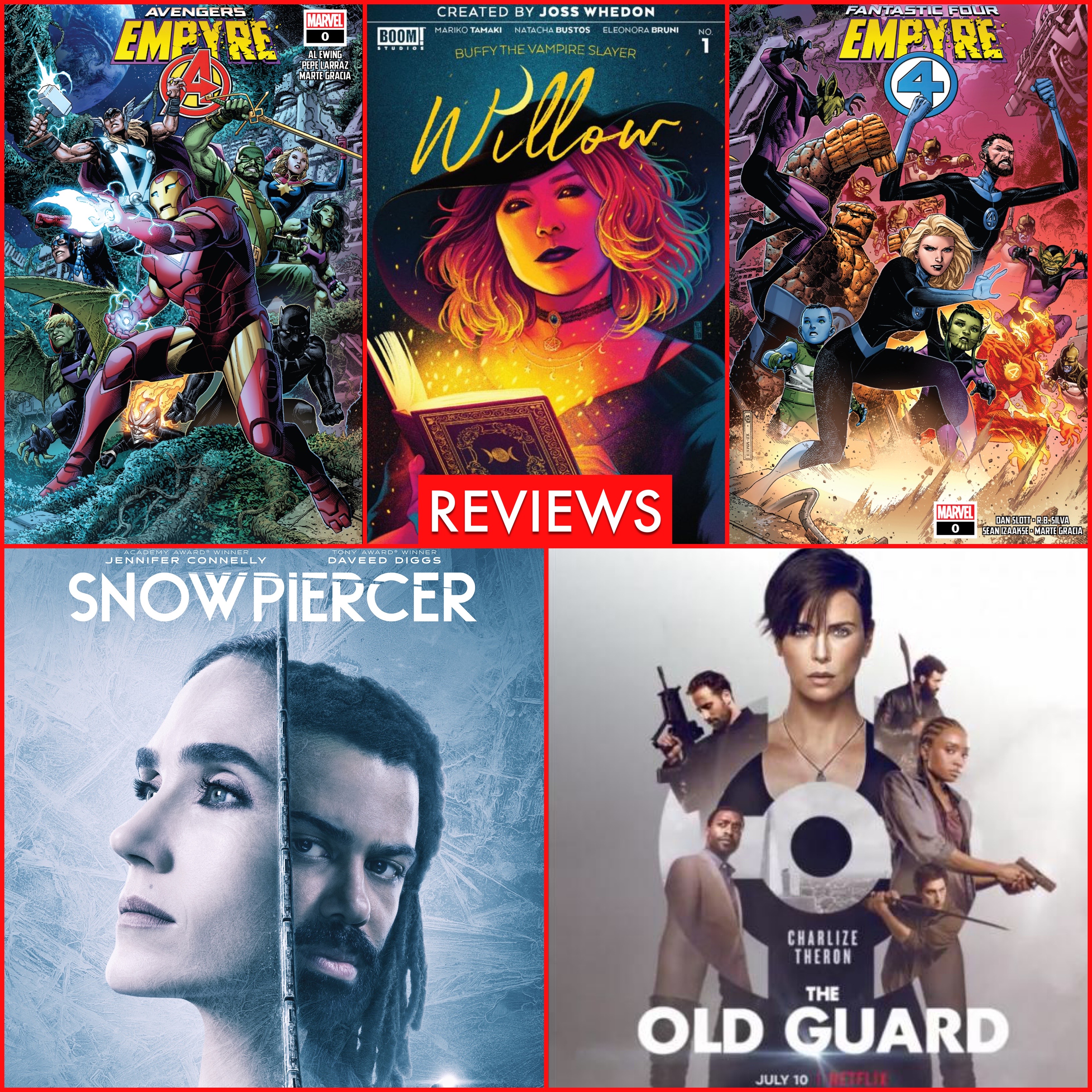JONATHAN HENNESSEY & MIKE SMITH
 SEND THIS TO A FRIEND! SEND THIS TO A FRIEND!
DF Interview: Hennessey, Smith bring story of beer to GN By Byron Brewer Starting from about 7,000 BC, The Comic Book Story of Beer traces beer's influence through world history, encapsulating early man's experiments with fermentation, the rise and fall of Ancient Rome, the (often beer-related) factors that led Europe out of the Dark Ages, the Age of Exploration, the spread of capitalism, the Reformation, and on up to the contemporary explosion of craft brewing. Written by Jonathan Hennessey and Mike Smith with art by Aaron McConnell, no book has ever told the story of beer in a graphic format as a liberating or emancipating force that improved the life of everyday people. Dynamic Forces wanted to check out this libation literacy, so we pulled up a stool in a local pub and chatted with both members of the writing team. Dynamic Forces: So, Jonathan, tell me how this project came into being. Gotta admit: it's different! Jonathan Hennessey: First off, Byron, thanks for reaching out. It's always a pleasure to be in touch with the Dynamic Forces crowd. And we're excited to let people know that The Comic Book Story of Beer will be out there soon! If you're attempting to work in comics of any kind, and you're not constantly thinking about what might work as an idea for a new project, then you're doing it wrong! Back in the summer of 2010 my nonfiction graphic novel The U.S. Constitution: A Graphic Adaptation had been on the shelves for almost two years. I live in Southern California, but I grew up in New England. So when I was starting my follow-up book on the Civil War, The Gettysburg Address: A Graphic Adaptation, it had been a snap to take the extra step of actually taking periodic research trips back east. Los Angeles isn't exactly bulging at the seams with historic battlefields and Abraham Lincoln sites, after all. It was a lucky break for me that one of my favorite people from my teenage years, someone whom I often wished I had gotten to know even better, had moved on and up from his job at Harpoon Brewery. People west of the Berkshires might not have heard of Harpoon. But in Boston it's a beer of distinction. Michael Smith had gone on to become head brewer at a scrappy startup down the coast in Plymouth, Massachusetts. My mother had started to spend her weekends in a small cottage there. So because they were right around the corner from each other, I got to see them both. Mike is a native of Cape Cod. And the people there have had a long reputation for being great storytellers and far less stingy with their affections (and affectations!) than other New Englanders. Henry David Thoreau wrote way back in the 1840s that Cape Codders are a people of "broad and invulnerable good humor." No exception, Mike was all graciousness and raconteurship when he took my mother, her boyfriend and I on a brewery tour. In no time flat, he was regaling us with fantastic stories from the history of beer. I had gone into the afternoon's entertainment thinking I understood how (and why!) beer is made. But it turned out to be far more complicated and way more interesting than I thought. "Beer," in fact, is a way more inclusive concept than you might think it is. And it's not limited at all to what you think of when you think about Bud Lite or Coors or even something fairly exotic for most casual beer drinkers, like a dark Guinness stout. As Mike spoke, I had one of those moments when you feel like the fog is being lifted, and so many of the things you've known seem to make perfect sense for a while. It struck me that if I felt this way, then other people might, too. I'm kind of an evangelist about history. I think it's empowering, emancipating even, to step back and glimpse all the raw ingredients that make up the present time—and all the good, bad and bizarro things that are part of being alive in the world right now. Beer is one of those things that cuts right through to the heart of almost everyone. It's an everyday thing in your hand or in your fridge. But it also inspires passion. And, furthermore, beer is a brilliant, almost bottomless slurry of human invention and human experience. I wanted people to revel in the same sense of dazzlement that had seized me up. So right there in the middle of the Mayflower Brewing Company floor, I had this "Eureka" moment. This could be the makings of a terrific graphic novel! I thought. I pitched it to Mike right then and there. When we finally got our act together with a formal book proposal and "proof of concept" art, we were lucky to quickly find a publisher who also thought the project had legs. Ten Speed Press, a division of Random House based in one of the foodie capitals of America—San Francisco's East Bay—liked it so much they are making it the very first graphic novel they have ever released. I knew that The Comic Book Story of Beer stood a chance to catch a wide audience. But just as importantly, I knew that working on it would make for one outstanding and refreshing break from writing about politics and war. Well, as it turns out, beer's history has its share of politics and war, too. For instance, tax revenue on beer in medieval times funded the purchase of not a few pikes, crossbows and siege engines! But at least you could always dull the pain with a few more swigs. DF: Mike, so you have in your time been a professional brewer (much like me, lol; get it?). How did you become involved in this unique graphic novel? Mike Smith: Well, you can be an honorary brewer after reading our book... Live up to your pedigree! Jonathan and I have been friends since our high school years. I started home brewing, sheesh, twenty something years ago. I have been a professional brewer for the last 15 years. My affinity for beer really began when I was an exchange student in Germany. The town I stayed in was outside Cologne, in northwestern Germany. The local beer there was Kölsch. Not something you find at your typical mid-1980s teenage keg party, right? So I suddenly found myself with untrammeled access to this delicious, local beer—in a country where the legal drinking age was agreeably south of 21. That was eye-opening. And so was just being immersed in a society where beer was an integral part of the culture. It was a few years after that that I started home brewing. Some college friends of mine introduced me to beer making and my mother gave me a kit for my birthday. I really took to it… I started exploring all the different styles – reading about them in British beer scribe Michael Jackson’s books, seeking out commercial examples (mostly imports at the time,) and trying to make my own versions. I was a decade or two too late to have been around for the origins of the craft brewing movement, but I lucked out by stumbling into it when it was still a bit “fringe.” My enthusiasm allowed me to get an entry-level job at a brewpub in Austin, Texas, when I moved there in my twenties. It’s been amazing to watch (from the “inside”) craft beer develop and explode into what’s going on today. DF: OK, guys – and without answering “beer,” lol -- what's the book all about? Mike Smith: The Comic Book Story of Beer is about the unique relationship between beer and civilization—and how they have molded one another from the dawn of time to the present. But it's also about an inspiring truth: that there has never been a better time on the face of the Earth to be a beer drinker than it is right now! Within our lifetimes, anyway, beer (in most places) just about bottomed out. Here in America in the late 1970s there were only forty four breweries and just about half that number of actual brands of beer! Can you imagine that? Now, not only do we have this exploding domestic craft beer market, but also we have the brewing output of practically the whole world at our fingertips. The diversity and availability of beer has never been better. And beer enthusiasts as a community have never been held in higher esteem. DF: What has been the greatest difficulty, or challenge, in putting this comic together? Mike Smith: Well, for most of this project Jonathan was in L.A., Aaron was in Portland, Oregon, and I was in Connecticut. Our publisher is in the San Francisco Bay Area. And our agent is in New York City! This was a very "modern," multi-coastal project. So a lot of it happened in fits and starts. The biggest challenge was the time lag for every little piece of the project to fall into place: first, the research and structure of the book, figuring out not only what to put in but what to leave out! Jonathan Hennessey: At one point the manuscript swelled to over twice the size the publisher was expecting. And that's a huge deal when you consider a book company's expenses for full color printing, superior paper stock, warehousing, shipping, and so on. Not to mention what a strain it would be on Aaron and Tom, our letterer! Our editor was like, "Let's get real, you guys." And we had to streamline the material and leave out some highly tasty stuff—especially about beer outside of the European and American experience. There was also the matter of parsing out a lot of stubborn and meddling beer myths. Myths that make great stories and seem to have the ring of truth to them, but only because they have been repeated so often. The legions of people who were tinkering with beer and helping it evolve didn't necessarily realize they were making history. So they didn't leave a lot of records behind for would-be "scholars" like us to pick up on. Mike Smith: Take the idea that porter was first made in some London tavern by an enterprising barkeep cutting expensive, high-quality beer with two grades of cheaper stuff. This is just not historically verifiable. Yet the story keeps getting repeated because a version of it somehow crept into one 19th century book, which was then referenced and referenced again by later writers like in some game of "Grandma's Telephone." Or take the old yarn about how no one in Great Britain drank India Pale Ale until a ship carrying it to the Far East wrecked in the North Sea—and barrels of hoppy brew free for the taking started washing up on beaches. Not only did that never take place, but also the truth is both murkier and considerably less "sexy." Jonathan Hennessey: It's very tempting to uncover a good story and run with it. Yet Mike was absolutely committed to purging this book of the sin of regurgitating these sometimes fun but insupportable anecdotes. Mike Smith: In retrospect, I think all these challenges made The Comic Book Story of Beer a better finished product. There were times when some of us really wanted to seize the moment and get the book out there. But quality work just cannot be rushed. When it came to both writing and producing the art, we had to maintain a pace that allowed us to ruminate and refine. Ten Speed Press's commitment to treat every word and sentence in this graphic novel with the same high standards they would treat a work of literature was part of that too. Jonathan Hennessey: I don't think our stalwart and industry veteran letterer, Tom Orzechowski, had ever faced so many revisions! DF: Jonathan, I think it is wonderful how you have taken history in most of your works and not only weaved it into the storyline as other writers have done but actually made it the prime focus of the OGN. Where does your love of history come from? Jonathan Hennessey: There was a time, when I was a teenager and maybe even into my twenties, when I could not have imagined a subject more boring and almost infuriatingly irrelevant. Nearly everyplace you go has a distinct sense of its past. But when you are raised in a place like Massachusetts history is formalized and codified and it's everywhere, and as a kid it's constantly being thrust in your face. At one time I wanted to think about the future and the future only. I really had blinders on. Then I slowly came to realize that it's impossible to appreciate and understand the present without coming to know what undergirds it. Like a lot of dudes my age I went through a Beat Poets stage, too. And that tradition fetishized things like travel and music and the ability to get to know and be okay with people very different from yourself. So when your physical and cultural horizons start to broaden, I think it's only natural for any curious person to want to know why this place is so different from that, why they do things this way here and not there. Studying history actually does the exact opposite of what many people think it does. It doesn't dull your sense of what's going on around you. It enriches it. Deeply. And I'll be damned if The Comic Book Story of Beer doesn't make everyone who reads it actually enjoy beer more than they did beforehand! As it turns out, yes, even your taste buds get better through education. DF: Mike, how did you apply your professional knowledge into this work? Can you tell me a little about how you and Jonathan work together on this? Mike Smith: I think a lot of what I brought to the table (and Jonathan, correct me if I'm wrong,) is a "Big Picture" view of things. Beer has been such a big part of my life for so long. My background helped me to clarify and filter ideas, concepts, and historical nuggets that Jonathan dredged up. Also, I've given countless brewery tours and talks over the years so I have developed a feel for how to boil down and to explain pretty complex brewing concepts. Jonathan and I spent a week of furious all-nighters holed up in Plymouth hammering out a lot of the framework for this book. But the vast majority of the further writing and editing was done over email. I used to think that the data on my Gmail account was endless. Well, I managed to fill most of that up!!! This is my first experience with writing anything, let alone a graphic novel. So it has been a very interesting exercise to say the least! We would start by brainstorming and bouncing ideas off each other as to what direction we wanted to take a particular chapter or episode. Then one of us (primarily Jonathan, but I have a few chapters in there) would write a prose version of the chapter. I think this comes from Jonathan's film and TV writing background, because then he would take that prose and essentially make a script out of it. We would research visual references and insert them into the script as cues for Aaron, much like a scriptwriter would do for a director or cinematographer. Then we would refine, refine, refine and edit. From there, Aaron would go to work. Then lots more refining and editing! DF: How has it been working with artist Aaron McConnell? Tell us a little about the style of illustration he uses here. Mike Smith: As I mentioned, this is my first experience with anything like this so it's been eye-opening to see the process work form "behind the scenes." I imagine it's like if someone came in to a brewery for the first time and watched me work. It appears to be magic at first. But in reality it's the steady effort of craftsmanship punctuated here and there with moments of risk-taking and true, original artistry. I acquired a few original pages from Aaron and find it super cool how each one tells a story through his technique. For example, one of the pages I have involves Fritz Maytag. Maytag was a descendant of the family responsible for the eponymous washing machines and blue cheese. He didn't necessarily start the craft beer movement single-handed... But he's way, way up there in the pantheon of the people who remade beer culture in the United States. Anyway, in the book we have a sequence set in 1960s San Francisco. It depicts Maytag walking into one of the great, bohemian watering holes of the day and learning of the imminent demise of Anchor Brewing—a small, local company that had somehow held out from years of corporate consolidation but was then seriously on the ropes. (Maytag then decides to purchase the brewery and basically start the whole Craft Beer revolution. But you'll have to read the book for that!) Anyway, in Aaron's early pencils version, the patrons in the bar's background are kind of square. Buttoned-down types. I requested to Aaron that he "hip" them up a bit. On the original piece of art, you can see a palimpsest of the earlier characters in their suits and ties overwritten and inked as 1960s scenesters. Aaron also managed to put a cameo of my girlfriend in that scene, so of course I love that! Jonathan Hennessey: The best thing about Aaron's illustration style here is that it's super versatile. He's on the same nimbly-balance footing with expressive and detailed yet totally accessible art whether he's showing us the Stone Age Middle East (one of several places where brewing seems to have been independently invented), Medieval Germany, Industrial Revolution-Era England, or the Berkeley, California, famous for hippies and student protests. Then sometimes just to keep us all on our toes Aaron drastically changes up the style and gives us something technical, cartoonish, painterly, or wildly kinetic. Yet everything hangs together into a coherent whole! That's perfect, because The Comic Book Story of Beer takes us in so many wildly different directions and to so many surprising places. The world wars, the ancient Greeks and Romans, servants and officials of Chinese dynasties, the pioneers of capitalism who dared to push back against tyrannical kings and popes, and Odin-worshipping barbarians in the fens of Northern Europe all left their marks on beer. The book tells us all about that, and Aaron's deft work with pencil, ink, and color (yes, he was often doing all three!) goes right along every step of the way. Dynamic Forces would like to thank Jonathan Hennessey and Mike Smith for taking time out of their busy schedules to answer our questions. The Comic Book Story of Beer is available for preorder now, and will be on bookstore shelves coast to coast on October 6th! For more news and up-to-date announcements, join us here at Dynamic Forces,www.dynamicforces.com/htmlfiles/, “LIKE” us on Facebook, www.facebook.com/dynamicforcesinc, and follow us on Twitter, www.twitter.com/dynamicforces.
NEW! 1. 09/23/2025 - FRANK BARBIERE2. 09/16/2025 - RODNEY BARNES 3. 09/10/2025 - ZACK KAPLAN 4. 08/26/2025 - JOE PRUETT 5. 08/20/2025 - CHRISTIAN WARD Show All |







